
 |
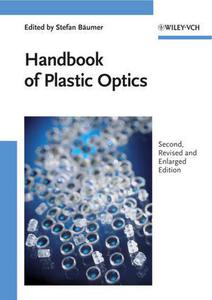 Handbook of Plastic Optics By Stefan Bäumer (ed.) 2010 | 303 Pages | ISBN: 3527409408 | PDF | 7 MB A coherent overview of the current status of injection molded optics, describing in detail all aspects of plastic optics, from design issues to production technology and quality control. This updated second edition is supplemented by a chapter on the equipment and process of injection wells as well as a look at recent applications. The contributors, each one a leading expert in their discipline, have either a background in or strong ties to the industry, thus combining a large amount of practical experience. With its focus firmly set on practical applications, this is an indispensable reference for all those working in optics research and development. 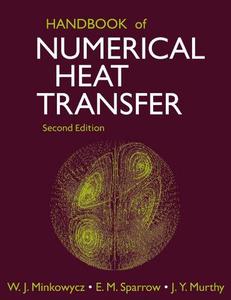 Handbook of Numerical Heat Transfer, Second Edition By 2006 | 963 Pages | ISBN: 0471348783 | PDF | 138 MB A completely updated edition of the acclaimed single-volume reference for heat transfer and the thermal sciences This Second Edition of Handbook of Numerical Heat Transfer covers the basic equations for numerical method calculations regarding heat transfer problems and applies these to problems encountered in aerospace, nuclear power, chemical processes, electronic packaging, and other related areas of mechanical engineering. As with the first edition, this complete revision presents comprehensive but accessible coverage of the necessary formulations, numerical schemes, and innovative solution techniques for solving problems of heat and mass transfer and related fluid flows. Featuring contributions from some of the most prominent authorities in the field, articles are grouped by major sets of methods and functions, with the text describing new and improved, as well as standard, procedures. Handbook of Numerical Heat Transfer, Second Edition includes: * Updated coverage of parabolic systems, hyperbolic systems, integral-and integro-differential systems, Monte Carlo and perturbation methods, and inverse problems * Usable computer programs that allow quick applications to aerospace, chemical, nuclear, and electronic packaging industries * User-friendly nomenclature listings include all the symbols used in each chapter so that chapter-specific symbols are readily availableContent: Chapter 1 Survey of Numerical Methods (pages 1-51): J. Y. Murthy, W. J. Minkowycz, E. M. Sparrow and S. R. MathurChapter 2 Finite?Difference Method (pages 53-90): Richard H. PletcherChapter 3 Finite?Element Method (pages 91-123): Juan C. HeinrichChapter 4 Boundary?Element Method (pages 125-165): A. J. Kassab, L. C. Wrobel, R. A. Bialecki and E. A. DivoChapter 5 Large Eddy Simulation of Heat and Mass Transport in Turbulent Flows (pages 167-189): Cyrus K. Madnia, Farhad A. Jaberi and Peyman GiviChapter 6 Control?Volume?Based Finite?Difference and Finite?Element Methods (pages 191-224): B. R. Baliga and N. AtabakiChapter 7 Meshless Methods (pages 225-247): D. W. PepperChapter 8 Monte Carlo Methods (pages 249-295): A. Haji?Sheikh and J. R. HowellChapter 9 Discrete?Ordinates and Finite?Volume Methods for Radiative Heat Transfer (pages 297-323): J. C. Chai and S. V. PatankarChapter 10 Pressure?Based Algorithms for Single?Fluid and Multifluid Flows (pages 325-367): F. Moukalled and M. DarwishChapter 11 Numerical Modeling of Heat Transfer in Wall?Adjacent Turbulent Flows (pages 369-388): T. J. Craft, S. E. Gant, A. V. Gerasimov, H. Iacovides and B. E. LaunderChapter 12 A Critical Systhesis of Pertinent Models for Turbulent Transport through Porous Media (pages 389-416): K. Vafai, A. Bejan, W. J. Minkowycz and K. KhanaferChapter 13 Verification and Validation of Computational Heat Transfer (pages 417-442): Dominique Pelletier and Patrick J. RoacheChapter 14 Sensitivity Analysis and Uncertainty Propagation of Computational Models (pages 443-469): B. F. Blackwell and K. J. DowdingChapter 15 Computational Geometry, Grid Generation, and Adaptive Grids (pages 471-492): Graham F. CareyChapter 16 Hybrid Methods and Symbolic Computations (pages 493-522): Renato M. Cotta and Mikhail D. MikhailovChapter 17 Inverse Problems in Heat Transfer (pages 523-557): Nicholas ZabarasChapter 18 Moving?Boundary Problems (pages 559-592): Wei ShyyChapter 19 Numerical Methods for Phase?Change Problems (pages 593-622): V. R. VollerChapter 20 Computational Techniques for Microscale Heat Transfer (pages 623-657): Da Yu "Robert" Tzou and James C. DowellChapter 21 Molecular Dynamics Method for Micro/Nano Systems (pages 659-695): Shigeo MaruyamaChapter 22 Eulerian?Lagrangian Simulations of Particle/Droplet?Laden Turbulent Flows (pages 697-728): F. Mashayek and W. J. MinkowyczChapter 23 Numerical Modeling of Manufacturing Processes (pages 729-783): Yogesh JaluriaChapter 24 Computational Methods in Materials Processing (pages 785-819): R. PitchumaniChapter 25 Thermal Modeling of Technology Infrastructure Facilities: A Case Study of Data Centers (pages 821-849): J. Rambo and Y. JoshiChapter 26 Numerical Bioheat Transfer (pages 851-893): B. RubinskyChapter 27 High?Performance Computing for Fluid Flow and Heat Transfer (pages 895-920): D. W. Pepper and J. M. LombardoChapter 28 Overview of Numerical Methods and Recommendations (pages 921-945): S. R. Mathur, W. J. Minkowycz, E. M. Sparrow and J. Y. Murthy
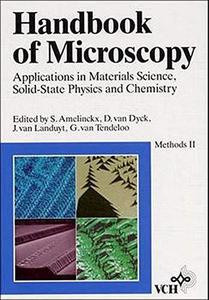 Handbook of Microscopy: Methods II: Applications in Materials Science, Solid-State Physics and Chemistry, Volume 2 By 1997 | 492 Pages | ISBN: 3527294732 | PDF | 30 MB Comprehensive in coverage, written and edited by leading experts in the field, this Handbook is a definitive, up-to-date reference work. The Volumes Methods I and Methods II detail the physico-chemical basis and capabilities of the various microscopy techniques used in materials science. The Volume Applications illustrates the results obtained by all available methods for the main classes of materials, showing which technique can be successfully applied to a given material in order to obtain the desired information. With the Handbook of Microscopy, scientists and engineers involved in materials characterization will be in a position to answer two key questions: "How does a given technique work?", and "Which techique is suitable for characterizing a given material?" Content: Chapter 2.1 Scanning Electron Microscopy (pages 539-561): Chapter 2.2 Scanning Transmission Electron Microscopy (pages 563-594): Chapter 2.3 Scanning Transmission Electron Microscopy: Z Contrast (pages 595-620): Chapter 2.4 Scanning Auger Microscopy (SAM) and Imaging X?Ray Photoelectron Spectroscopy (XPS) (pages 621-640): Chapter 2.5 Scanning Microanalysis (pages 641-659): Chapter 2.6 Imaging Secondary Ion Mass Spectrometry (pages 691-716): Chapter 1 Nuclear Magnetic Resonance (pages 719-734): Chapter 2 Scanning Electron Microscopy with Polarization Analysis (SEMPA) (pages 735-749): Chapter 3 Spin?Polarized Low?Energy Electron Microscopy (pages 751-759): Chapter 1 Photoelectron Emission Microscopy (pages 763-773): Chapter 2 Field Emission and Field Ion Microscopy (Including Atom Probe FIM) (pages 775-801): Chapter 1 Scanning Tunneling Microscopy (pages 809-826): Chapter 2 Scanning Force Microscopy (pages 828-844): Chapter 3 Magnetic Force Microscopy (pages 845-853): Chapter 4 Ballistic Electron Emission Microscopy (pages 855-882): Chapter 1 Image Recording in Microscopy (pages 885-921): Chapter 2 Image Processing (pages 923-952): Chapter 1 Coincidence Microscopy (pages 955-962): Chapter 2 Low Energy Electron Holography and Point?Projection Microscopy (pages 963-986):
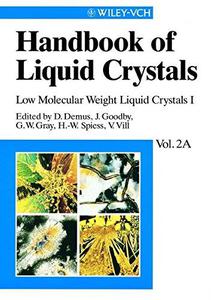 Handbook of Liquid Crystals: Low Molecular Weight Liquid Crystals I, Volume 2 A By Prof. D. Demus, Prof. J. Goodby, Prof. G. W. Gray, Prof. H.?W. Spiess, Dr. V. Vill(auth.) 1998 | 525 Pages | ISBN: 3527292713 | PDF | 20 MB The Handbook of Liquid Crystals is a unique compendium of knowledge on all aspects of liquid crystals. In over 2000 pages the Handbook provides detailed information on the basic principles of both low- and high-molecular weight materials, as well as the synthesis, characterization, modification, and applications (such as in computer displays or as structural materials) of all types of liquid crystals. The five editors of the Handbook are internationally renowned experts from both industry and academia and have drawn together over 70 leading figures in the field as authors. The four volumes of the Handbook are designed both to be used together or as stand-alone reference sources. Some users will require the whole set, others will be best served with one or two of the volumes. Volume 1 deals with the basic physical and chemical principles of liquid crystals, including structure-property relationships, nomenclature, phase behavior, characterization methods, and general synthesis and application strategies. As such this volume provides an excellent introduction to the field and a powerful learning and teaching tool for graduate students and above. Volumes 2A and 2B concentrate on low-molecular weight materials, for example those typically used in display technology. A high quality survey of the literature is provided along with full details of molecular design strategies, phase characterization and control, and applications development. These volumes are therefore by far the most detailed reference sources on these industrially very important materials, ideally suited for professionals in the field. Volume 3 concentrates on high-molecular weight, or polymeric, liquid crystals, some of which are found in structural applications and others occur as natural products of living systems. A high-quality literature survey is complemented by full detail of the synthesis, processing, analysis, and applications of all important materials classes. This volume is the most comprehensive reference source on these materials, and is therefore ideally suited for professionals in the field. Content: Chapter I Phase Structures of Calamitic Liquid Crystals (pages 3-21): John W. GoodbyChapter II Phase Transitions in Rod?Like Liquid Crystals (pages 23-46): Daniel GuillonChapter III.1 Nematic Liquid Crystals: Synthesis of Nematic Liquid Crystals (pages 47-59): Kenneth J. ToyneChapter III.2.1 Nematic Liquid Crystals: Physical Properties, Section 2.1 (pages 60-90): Ralf StannariusChapter III.2.2 Nematic Liquid Crystals: Physical Properties, Section 2.2 (pages 91-112): Horst KresseChapter III.2.3 Nematic Liquid Crystals: Physical Properties, Section 2.3 (pages 113-127): Ralf StannariusChapter III.2.4 Nematic Liquid Crystals: Physical Properties, Section 2.4 (pages 128-141): Gerhard PelzlChapter III:2.5 Nematic Liquid Crystals: Physical Properties, Section 2.5 (pages 142-169): Herbert Kneppe and Frank SchneiderChapter III.2.6 Nematic Liquid Crystals: Physical Properties, Section 2.6 (pages 170-197): R. Blinc and I. MusevicChapter III.3.1 Nematic Liquid Crystals: Applications, Section 3.1 (pages 199-229): Harald Hirschmann and Volker ReiffenrathChapter III.3.2 Nematic Liquid Crystals: Applications, Section 3.2 (pages 230-242): Eiji KanekoChapter III.3.3 Nematic Liquid Crystals: Applications, Section 3.3 (pages 243-256): Birendra BahadurChapter III.3.4 Nematic Liquid Crystals: Applications, Section 3.4 (pages 257-302): Birendra BahadurChapter IV.1 Chiral Nematic Liquid Crystals: The Synthesis of Chiral Nematic Liquid Crystals (pages 303-334): Christopher J. BoothChapter IV.2 Chiral Nematic Liquid Crystals: Chiral Nematics: Physical Properties and Applications (pages 335-409): Harry ColesChapter V.1 Non?Chiral Smectic Liquid Crystals: Synthesis of Non?Chiral Smectic Liquid Crystals (pages 411-440): John W. GoodbyChapter V.2 Non?Chiral Smectic Liquid Crystals: Physical Properties of Non?Chiral Smectic Liquid Crystals (pages 441-469): C. C. HuangChapter V.3 Non?Chiral Smectic Liquid Crystals: Nonchiral Smectic Liquid Crystals - Applications (pages 470-490): David Coates  Handbook of Jealousy: Theory, Research, and Multidisciplinary Approaches By 2010 | 587 Pages | ISBN: 1405185791 | PDF | 6 MB Through a compilation of original articles, the Handbook of Jealousy offers an integrated portrait of the emerging areas of research into the nature of jealousy and a forum for discussing the implications of the findings for theories of emotional and socio-cognitive development. Presents the most recent findings and theories on jealousy across a range of contexts and age-stages of development Includes 23 original articles with empirical findings and detailed commentaries by leading experts in the field Serves as a valuable resource for professionals in the fields of clinical psychology, psychiatry, and social work, as well as scholars in the fields of psychology, family studies, sociology, and anthropology Content: Chapter 1 Jealousy in Western History (pages 5-26): Peter N. StearnsChapter 2 Loss, Protest, and Emotional Development (pages 27-39): Michael LewisChapter 3 Jealousy and Romantic Love (pages 40-54): Aaron Ben?Ze'evChapter 4 The Ontogenesis of Jealousy in the First Year of Life (pages 55-82): Sybil L. HartChapter 5 Neural Structures of Jealousy (pages 83-100): Gabriela Markova, James Stieben and Maria LegersteeChapter 6 The Evolutionary Sources of Jealousy (pages 101-120): Jaak PankseppChapter 7 Sibling Rivalry in the Birds and Bees (pages 121-143): Scott ForbesChapter 8 Green Eyes in Bio?Cultural Frames (pages 144-160): Vasudevi ReddyChapter 9 Social Bonds, Triadic Relationships, and Goals (pages 161-191): Maria Legerstee, Baila Ellenbogen, Tom Nienhuis and Heidi MarshChapter 10 Jealousy in Infant-Peer Trios (pages 192-234): Ben S. BradleyChapter 11 Parental Reports of Jealousy in Early Infancy (pages 235-266): Riccardo Draghi?LorenzChapter 12 Jealousy in Autism Spectrum Disorders (ASD) (pages 267-292): Nirit BaumingerChapter 13 Is Jealousy a Complex Emotion? (pages 293-311): R. Peter HobsonChapter 14 What Is Missing in the Study of the Development of Jealousy? (pages 312-328): Joseph J. Campos, Eric A. Walle and Audun DahlChapter 15 A Theoretical Model of the Development of Jealousy (pages 329-361): Sybil L. HartChapter 16 Jealousy and Attachment (pages 362-386): R. M. Pasco Fearon, Marian J. Bakermans?Kranenburg and Marinus H. van IjzendoornChapter 17 The Development of Sibling Jealousy (pages 387-417): Brenda L. Volling, Denise E. Kennedy and Lisa M. H. JackeyChapter 18 The Socialization of Sibling Rivalry (pages 418-442): Sybil L. HartChapter 19 Family Triangular Interactions in Infancy (pages 443-476): Elisabeth Fivaz?Depeursinge, Nicolas Favez, Chloe Lavanchy Scaiola and Francesco LopesChapter 20 Culture, Parenting, and the Development of Jealousy (pages 477-497): Heidi Keller and Bettina LammChapter 21 Social Class, Competition, and Parental Jealousy in Children's Sports (pages 498-515): Noel DyckChapter 22 When Friends Have Other Friends (pages 516-546): Jeffrey G. Parker, Sara A. Kruse and Julie Wargo AikinsChapter 23 Jealousy in Adulthood (pages 547-571): Christine R. Harris and Ryan S. Darby
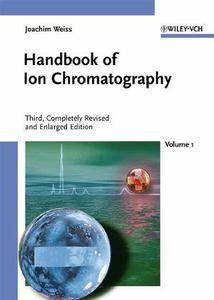 Handbook of Ion Chromatography, Third, completely revised and updated edition By Joachim Weiss(auth.) 2004 | 904 Pages | ISBN: 3527287019 | PDF | 16 MB The third edition of this standard reference by one of the pioneers in the field has been completely revised and doubled in size to cover the numerous developments with respect to applications and instrumentation. Now running to two volumes, added chapters or sections include: - A new chapter devoted to ion exchange chromatography - Hyphenation with mass spectrometry, including ICP/MS - Applications for analysis of carbohydrates, proteins and nucleic acids - Validation of ion-chromatographic methods With its additional new figures and chromatograms, this handbook remains unparalleled in its timeliness and comprehensiveness.Content: Chapter 1 Introduction (pages 1-11): Chapter 2 Theory of Chromatography (pages 13-25): Chapter 3 Anion Exchange Chromatography (HPIC): Sections 3.1-3.7 (pages 27-168): Chapter 3 Anion Exchange Chromatography (HPIC): Sections 3.8-3.10 (pages 168-278): Chapter 4 Cation Exchange Chromatography (HPIC) (pages 279-357): Chapter 5 Ion?Exclusion chromatography (HPICE) (pages 359-392): Chapter 6 Ion?Pair Chromatography (MPIC) (pages 393-459): Chapter 7 Detection Methods in Ion Chromatography (pages 461-547): Chapter 8 Quantitative Analysis (pages 549-586): Chapter 9 Applications: Sections 9.1-9.4 (pages 587-697): Chapter 9 Applications: Sections 9.5-9.8 (pages 697-797): Chapter 9 Applications: Sections 9.9-9.11 (pages 797-839): 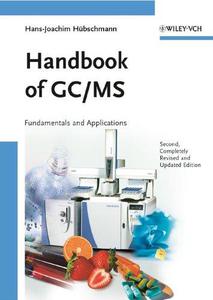 Handbook of GC/MS: Fundamentals and Applications, Second Edition By Dr. Hans?Joachim Hubschmann(auth.) 2008 | 732 Pages | ISBN: 352731427X | PDF | 9 MB This is the first comprehensive reference work for GC/MS now in its second edition. It offers broad coverage, from sample preparation to the evaluation of MS-Data, including library searches. Fundamentals, techniques, and applications are described. A large part of the book is devoted to numerous examples for GC/MS-applications in environmental, food, pharmaceutical and clinical analysis. These proven examples come from the daily practice of various laboratories. The book also features a glossary of terms and a substance index that helps the reader to find information for his particular analytical problem. The author presents in a consistent and clear style his experience from numerous user workshops which he has organized. This is a thoroughly revised and updated English edition based on an edition which was highly successful in Germany.Content: Chapter 1 Introduction (pages 1-6): Chapter 2 Fundamentals (pages 7-292): Chapter 3 Evaluation of GC/MS Analyses (pages 293-420): Chapter 4 Applications (pages 421-645): Chapter 5 Glossary (pages 647-691):
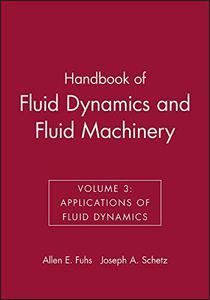 Handbook of Fluid Dynamics and Fluid Machinery: Applications of Fluid Dynamics, Volume III By 1996 | 638 Pages | ISBN: 0471140902 | PDF | 62 MB Content: Chapter 23 Fluid Dynamic Related Technologies (pages 1591-1846): Herbert S. Cheng, Malcom J. Crocker, Edward E. Zukoski, Julian Szekely, Raymond M. Hicks, Earl H. Dowell, E. Eugene Larrabee, Helmut Sockel, Sam P. Jones, James D. de Laurier, Fayette S. Collier, Fredrick G. Hammitt, William G. Day, Franklin T. Dodge, Allen E. Fuhs and A. George HavenerChapter 24 Fluid Dynamics in Nature (pages 1847-1989): Jackson R. Herring, Jack E. Cermak, Wayne L. Neu, Everett V. Richardson, Panayiotis Diplas, Richard H. Rand, George T. Yates, Geoffrey R. Spedding, James D. de Laurier, David P. Hoult and George D. AshtonChapter 25 Static Components of Fluid Machinery (pages 1991-2186): Bharatan R. Patel, C. Samuel Martin, John E. Minardi, Philip C. Stein, Reiner Decher, James L. Younghans, James L. Keirsey, William B. Shippen and Everett J. HardgraveChapter 26 Positive Displacement Compressors, Pumps, and Motors (pages 2187-2217): Richard NeerkenChapter 27 Turbomachinery (pages 2219-2576): David Japikse, Walter S. Gearhart, Robert E. Henderson, J. Gordon Leishman, Nicholas A. Cumpsty, Colin Rodgers, Terry Wright, Michael W. Volk, Edward M. Greitzer, Michael V. Casey, Helmut Keck, William G. Steltz, Tsukasa Yoshinaka, P. Sampath, Hany Moustapha, Ernest W. Upton, Louis V. Divone and Daniel F. AnconaChapter 28 Hydraulic Systems (pages 2577-2617): Hugh R. MartinChapter 29 Compressed Systems (pages 2619-2628): John P. Rollins  Handbook of Fire and the Environment: Impacts and Mitigation English | 2023 | ISBN: 3030943550 | 502 Pages | PDF (True) | 28 MB The fundamental purpose of this handbook is to raise awareness about environmental impacts of fire and fire suppression, primarily within the fire engineering and firefighting communities, but also within the environmental engineering and planning disciplines. The Handbook provides readers with a fundamental understanding of the problem and its magnitude and includes a set of tools and methods for assessing environmental, social and financial impacts, and a set of tools for identifying and selecting appropriate mitigation options. 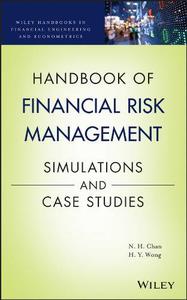 Handbook of Financial Risk Management: Simulations and Case Studies By N.H. Chan, H.Y. Wong(auth.) 2013 | 421 Pages | ISBN: 0470647159 | PDF | 8 MB This authoritative handbook illustrates practical implementation of simulation techniques in the banking and financial industries through use of real-world, time-sensitive applications. Striking a balance between theory and practice, it demonstrates how simulation algorithms can be used to solve practical problems and showcases how accuracy and efficiency in implementing various simulation methods can be used as indispensable tools in risk management. It also covers topics such as volatility, fixed-income derivatives, LIBOR Market Models, risk measures, and includes over two-dozen recognized simulation models.Content: Chapter 1 An Introduction to Excel VBA (pages 1-32): Chapter 2 Background (pages 33-70): Chapter 3 Structured Products (pages 71-119): Chapter 4 Volatility Modeling (pages 121-175): Chapter 5 Fixed?Income Derivatives I: Short?Rate Models (pages 177-216): Chapter 6 Fixed?Income Derivatives II: LIBOR Market Models (pages 217-253): Chapter 7 Credit Derivatives and Counterparty Credit Risk (pages 255-301): Chapter 8 Value?at?Risk and Related Risk Measures (pages 303-341): Chapter 9 The Greeks (pages 343-380): |